The Legacy of Joseph Barnabas in Cyprus
Paul's mentor and missionary traveling companion
September 27th, 2011
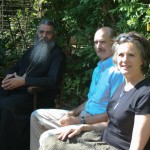 Lynne and me with Bishop Neophytos. Difficult photo to adjust the exposure. Today we met with Neophytos, Bishop of the Morphou region. Talking with him about Barnabas put my mind at rest regarding my project. He is quite aware of the sometimes contradictory claims made about the saints in the oral and written traditions of the church–vastly more aware than I am.
I was also relieved when he said that Barnabas probably did not write a text called The Epistle of Barnabas. I know that a Gentile Christian in Alexandria wrote this pervasively anti-Semitic document sometime between AD 70-135. The author speaks of “the wretched Jews” (16:2) and in chapter nine claims that circumcision resulted from the deception of an evil angel. Barnabas, a Jew from the tribe of Levi, did not write it (see http://www.earlychristianwritings.com/text/barnabas-roberts.html for the text).
Read the rest of this entry »
Posted in Uncategorized | 4 Comments »
September 26th, 2011
Sunday morning we met Father Gabriel at the Metochi tou Kykkou, a large monastic complex in Nicosia belonging to the Kykkos Monastery (an ancient and venerable monastery in the Troodos Mtns). His followers call him a national, spiritual treasure. At age 90, he is a bit frail, but his mind seems quite alert, and he has an air of peace and warmth about him.
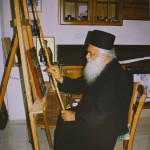 Father Gabriel painting an icon. A man we met last Sunday at the concert in Peristerona arranged for the meeting. He called on Saturday to ask, “Are you interested in meeting Father Gabriel?” Of course, I was. So he called a friend named Alex, who is a spiritual son of Gabriel’s. Again, I get opportunities because of the connections of people in Cyprus.
We met Alex and his wife at the Metochi Sunday morning. They took us to meet Gabriel, and placed a chair beside the man for me. I felt awkward but privileged. People came to receive his blessing, leaning past me to kiss his hand, or holding babies out for him to touch their heads. Gabriel asked why I came to Cyprus. Alex translated. Gabriel was pleased to learn that I came all the way from America to learn about Barnabas. He is the abbot of the Monastery of St. Barnabas in Salamis, which is under Turkish occupation. Read the rest of this entry »
Posted in Uncategorized | 1 Comment »
September 25th, 2011
 The scene of the crime On Thursday, Lynne and I visited the Church of Panayia Angeloktisti in Kiti, a small village near Larnaca. The name means the all-holy church built by angels. This 11th century Byzantine church replaced a 5th century sanctuary that was destroyed by Arabs. The only surviving part of the earlier church is the apse, which contains a rare, 6th century mosaic of Mary and Jesus between two archangels (Gabriel on the right and Michael on the left).
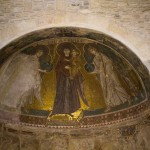 Mary and Child between the archangels Michael and Gabriel We were alone in the church, happily taking photos, when an elderly man came in and saw us with cameras. He began fussing at us and pulled out his phone and began dialing a number and said, “….Police.” There was no sign at the door saying not to take pictures, so we were surprised by his anger. Anyway, we retreated to our car and headed for the beach near Kiti.
No others were at the area where we put on our snorkeling gear, so we had the place to ourselves. The water was nice, and we enjoyed looking at the various rocks and vegetation under the water. But we saw very few fish—which was disappointing. Overall, however, we had a nice day, especially in light of the fact that we got out of Kiti before the police arrived. What is the penalty for taking a picture (without a flash, of course) in a church? Bad Kiti!!
Posted in Uncategorized | Comments Off on Evicted from Kiti Church
September 24th, 2011
 Our neighbor's truck, as seen from our balcony. Saturday, 12:01 AM
MEEOOWWW! HISS! SCREECH!
Rumble among the feral cats gathered below our balcony. Resolution of the conflict requires some time.
Saturday, 2:30 AM
BRAKES SCREECH! LID BANG! SHRILL WHISTLE! BACK-UP BEEPING! YELL TO MOVE TO NEXT DUMPSTER!
Trash collectors do their work at night in Nicosia. They reveal their exuberance.
Saturday, 3:00 AM
RRRROOOOAAAAARRRR!!!!!
Motorcycle race down Andreas Demetriou Street (in front of CAARI). Young men try to hit 100 by the end of the block. Read the rest of this entry »
Posted in Uncategorized | 5 Comments »
September 20th, 2011
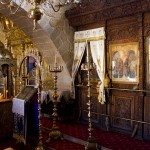 Front of the Church of St. Chrysaliniotissa in Nicosia This morning we anticipated meeting Father Gabriel, an 88-year old monk who heads the Barnabas Foundation. Dialoging with this man was going to be a highlight of the month. Two new friends were to drive up from Limassol, pick us up about 10:00, take us to Gabriel’s office and translate for us. A great plan.
About 9:00, our cell phone rang. “I am sorry, Michael, but we will have to postpone our meeting with Father Gabriel. He was taken to the hospital this morning.” When I expressed concern and asked what was wrong, my friend said, “Well, he is old.” I suppose it was inappropriate, but I was so taken by surprise that I could not help laughing.
So I spent all day in the library at CAARI translating ancient Greek texts that mention Barnabas. I started this project last week and have worked through 200 of them—which seems like a good accomplishment. The problem is that the computer database I am using generated 740 references in texts from the first through the 15th century. Oh, my aching back and head.
I am into the forth century now, and one thing is clear. Only a few texts so far have much relevance for my project. The dreadful thing about research is all the drudgery one goes through to discover material important for one’s work. Perhaps another trip to the beach would clear my mind and make me more productive. Maybe next week.
Posted in Uncategorized | 1 Comment »
September 19th, 2011
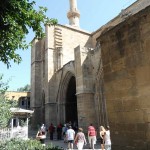 Muslims converted this Gothic Cathedral into a mosque. On Friday, Lynne and I walked into Turkish controlled northern Cyprus. Some Greek Cypriots call it The Dead Zone in memory of the 1974 Turkish invasion of north Cyprus. Officially, it is the Green Zone. UN troops are stationed in part of this zone in various places across the island. It is a bit spooky to see razor wire along the Turkish side of the dividing line. We have seen numerous bullet-pocked and bombed out buildings, but we are not supposed to take any photos in this area.
Going into north Cyprus turns out to be pretty easy. Instead of getting a stamp in our passport, however, we get a stamped piece of paper to put in our passport. That satisfies the Greek Cypriot refusal to give any legitimacy to the north as an independent entity by having their stamp on passports.
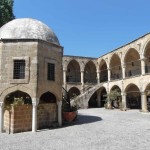 One of the earliest Ottoman constructions on the island, this building was a hotel. Now it is a place where people gather and venders sell their wares. We had a pleasant time walking along the streets, looking at sites like the Gothic Cathedral that was converted into a mosque. We will return soon to see other sites.
I am currently reading a book titled Echoes from the Dead Zone: Across the Cyprus Divide, by Yiannis Papadakis. The Greek Cypriot author lived in both north and south Cypus, Greece and Turkey, listening to people tell their stories. The pain and suspicion experienced by people in all these groups has many similarities. But each group has a collective memory that deadens them to the perspectives of the others. It is a fascinating and revealing work.
Posted in Uncategorized | 2 Comments »
September 19th, 2011
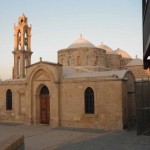 The Church of Saints Barnabas and Hilarion at Peristerona Sometimes I know just enough about something to be dangerous. I am so focused on learning about Joseph Barnabas that I neglect to remember that there are other saints named Barnabas. The Church of Saints Barnabas and Hilarion described in my previous post has nothing to do with the apostle Barnabas. As it turns out, these two men were soldiers in the Byzantine Empire and lived in what today is Turkey. They gave up soldiering and became holy men.
I knew that the icons of Barnabas in that church looked different, and I was trying to figure out why he was not depicted as he normally is. Now, to my embarrassment, I know the reason. Different Barnabas.
Last night we attended a concert held very near The Church of Saints Barnabas and Hilarion in Peristerona. Five music teachers performed traditional eastern Mediterranean music. Lynne and I had a great time being in the midst of those who came to hear the songs. One man asked if we represented an embassy. When he learned that I am doing research on Barnabas, he said that I must meet the Bishop of the Morphou region—who attended the concert. During intermission, he took me to the bishop, who turns out to be a very tall and gracious man. We will visit him at his office next week and ask questions about Barnabas.
I also have an appointment to meet the archbishop of Cyprus and two other bishops. So I will soon be able to interview these men, who will probably arrange for me to meet with other clergy and monastics. Things are beginning to come together. Now, if I can just be more careful about identifying saints.
Posted in Uncategorized | Comments Off on Relics and Traditional Cypriot Music
September 12th, 2011
 Inside the Church Today we drove to the Church of Saints Barnabas and Hilarion. It is a small church, as are most of the older Orthodox churches. Some of the new ones we see around Nicosia are quite large. The Cypriots with whom we speak do not care for the larger buildings—too impersonal. Anyway, this morning we met a very friendly young man who had arranged for someone to come and unlock the church door.
 Relics of Barnabas At one time the stones inside this old church were plastered and covered with frescos. Today, the rocks are bare, but the iconostasis is ornate. And, most important for me, the church not only has icons of Barnabas, but also some relics. Our young guide took us to an ornate display box in the front left of the church and explained that the bones and the top of a skull in this silver container are the bones of Barnabas.
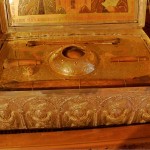 Closeup of the bones. I am amazed by the sincere reverence Orthodox Christians have for icons—for the way they kiss certain ones and bow before them. Icons for them are not simply works of art, but holy objects that bring them closer to God. My Protestant background is quite removed from such veneration of relics, so I am still in a situation of having much to learn and experience.
Posted in Uncategorized | 2 Comments »
September 9th, 2011
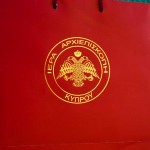 This morning, while I was paging through books on the history of Christian art in Cyprus, a CAARI employee walked up to me and said, “This book is from Father Savvas.” She handed me a paper bag with the official seal of the archbishopric on it, and inside was a large format book: Christian Art in the Turkish-Occupied Part of Cyprus, by A. Papageorghiou. This morning, while I was paging through books on the history of Christian art in Cyprus, a CAARI employee walked up to me and said, “This book is from Father Savvas.” She handed me a paper bag with the official seal of the archbishopric on it, and inside was a large format book: Christian Art in the Turkish-Occupied Part of Cyprus, by A. Papageorghiou.
The book was a gift from an official in the archbishopric here in Nicosia. A couple at the Orthodox Church we attended last week gave us his name and phone number. So I called him and explained my research. He was quite helpful and gave me a list of people I should call and ask to meet. And today he sent one of his assistants to CAARI to give a book to me.
The book details the destruction and desecration of churches and monasteries in the northern part of Cyprus by Turkish soldiers and Cypriots of Turkish ancestry following the 1974 occupation of north Cyprus by the Turkish army. It is carefully documented and lavishly produced with many photos. It tells a tragic account of wanton destruction of Christian relics and wholesale plundering of them to sell the icons and other objects of art on the black-market. Read the rest of this entry »
Posted in Uncategorized | 1 Comment »
September 7th, 2011
 Terraced hills in the Troodos We got our car today and decided to go for a drive into the Troodos mountains I have to admit that I was apprehensive about driving on the left side of the road, but I did okay–all things considered. We drove first to a small village west of Nicosia that has a Church of St. Barnabas. It was locked, but as we stood looking at it a young man emerged from a nearby building. He told us that he knows the old man who has the keys to the church and can let us in to see it.
As it turns out, he is a musician who is training youth in the village on how to play traditional Cypriot music. He proudly showed us the little school where he works. During the conversation, he said that he would love to be able to show us some things in the area. So, we have another good contact–another friendly and helpful Cypriot. We look forward to seeing the inside of the church and also to attending a concert there on Sept. 18, when the young man and his colleagues will play traditional music.
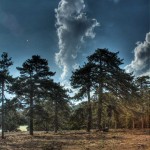 Black Pine have flat tops The road to the top of the Troodos Mountains is steep and windy. Even at high elevations, we noticed that a lot of the hills are terraced for orchards. Near the top of the mountains there are numerous Black Pine, and they mostly have flat tops. We are a bit puzzled as to why.
On our return back to CAARI, of course, we got lost in Nicosia. I stopped to ask directions from a pleasant man who is from Romania. He couldn’t speak English, but he and Lynne exchanged a few Romanian phrases. He took us to an elderly Greek neighbor who knew just enough English to show us on our map where we were. We finally managed to get to our temporary home, and we felt quite happy to be here.
Posted in Uncategorized | 1 Comment »
|
|
 |
|
Monthly Archives:
Categorical Archives:
|

















